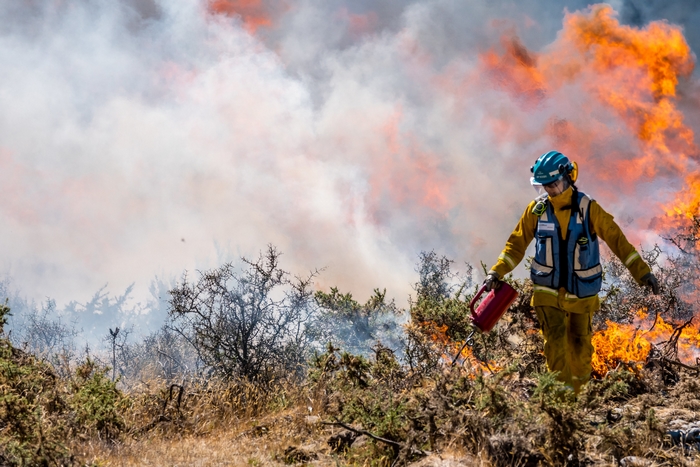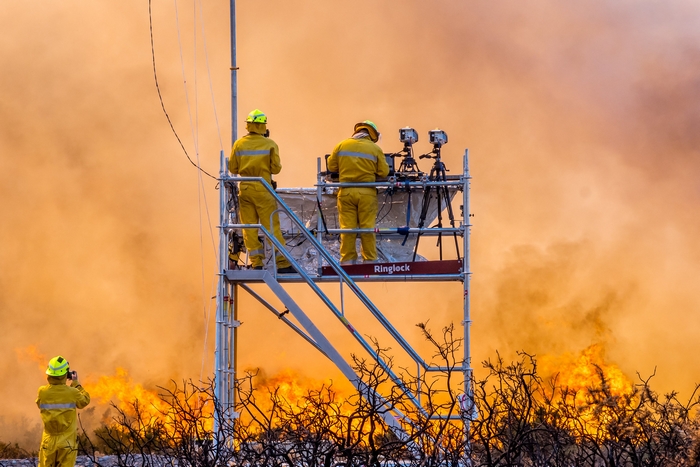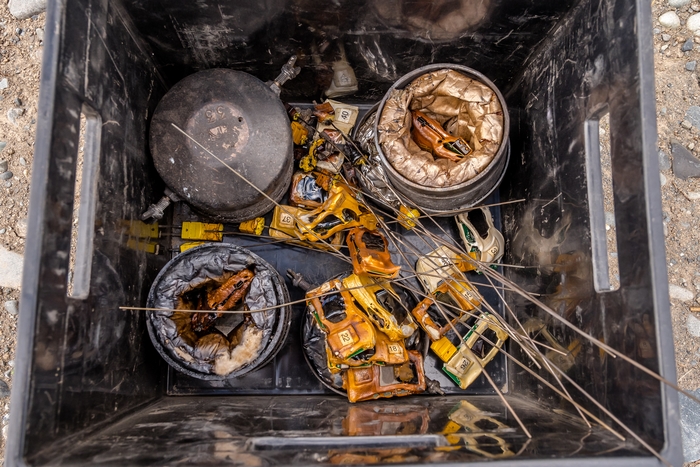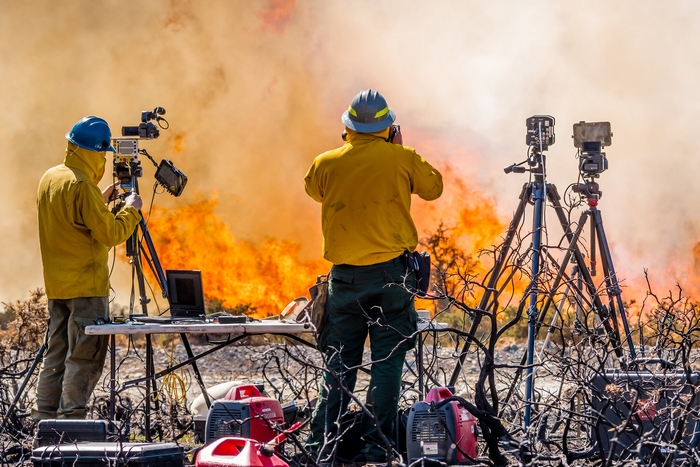You've got to burn to learn

This March, Scion’s rural fire research team completed six experimental burns of gorse scrub in the Rakaia Gorge, Canterbury, that had taken over 18 months of preparation. The burns are part of a set of experiments in different vegetation fuel types to test a new fire spread theory. The burns were carried out safely and a lot of valuable data collected thanks to good planning, firebreaks, pre-burns, and the involvement of Fire and Emergency New Zealand, the Department of Conservation and local fire volunteers. This data will go on to provide insights into fire behaviour in scrub fuels and ultimately help protect people, property and the environment.

How hot?
Gorse is renowned for its heavy fuel loadings that produce high intensity fires. But Scion and international scientists were surprised by just how hot their controlled fires were. An infra-red camera mounted on a drone at the edge of a burn reached the upper limit of its sensing capabilities at around 940°C. In-fire cameras blistered as the water that was supposed to keep them cool boiled off, and data loggers melted inside well-insulated housings. The temperatures in the centre of the fires were measured to have reached almost 1,500°C.
But why is it necessary to light fires to study fire? Fire scientists are testing a new theory about the roles of heat transfer mechanisms in how fire spreads, and studying wildfires under closely controlled, highly uniform laboratory conditions is not very realistic. The best way to study fire behaviour is in situations as close as possible to naturally varying, real world conditions.
New Zealand is one of the very few countries where large experimental burn projects are still possible – largely due to the relationships built up by the Scion rural fire research team with Fire and Emergency New Zealand. The burns attract worldwide interest from fire researchers. The gorse burns were scrutinised by researchers from the US Forest Service, San Jose State University and the University of Canterbury, as well as the Scion fire team. The amount of instrumentation, and the number of cameras and drones watching and recording ensured the recent fires were, according to the research team, the most closely observed burns in New Zealand to date.

How do fires spread?
Flame fronts have been observed to ‘pulse’, with flames pushing out ahead of the fire front where they can directly come into contact with and ignite new fuels. This has led to a new theory about the way wildfire spreads. Instead of an evenly spreading flame front radiating heat into unburnt fuels ahead, fire scientists are investigating whether the hot air rising from the fire is replaced by colder air sweeping in from behind and propelling the flames forward. The process creates a series of peaks and troughs within the burning flame front, with flame peaks in areas where the air is rising and pulling the flame upward, and troughs formed by the cool air circulating down.
The theory was first proposed by the US Forest Service based on lab-scale fire tests carried out in the Missoula Fire Sciences Laboratory. The next stage was experimental burns carried out in cereal crop stubble fields near Christchurch in 2018 and 2019, with the evenly spaced crop rows and uniform stubble height closely mimicking laboratory fire conditions.
Each of the two to four-hectare stubble burn sites was also wired and monitored with in-fire temperature and wind sensors, cameras and high-speed thermal imaging equipment. The fire behaviour observed during the stubble burns was similar to that seen in the laboratory.
Gorse, with its heavier fuel loads, was next chosen to model fire behaviour in less uniform scrub-type fuels. Beyond that, the team plans to continue their work in more complex vegetation, such as wilding pines, which can form dense thickets that also have very high fuel loads that contribute to crown fires with even larger flames.
A new theory of fire spread.
Why do we need to understand fire behaviour?
The experimental burns are a part of a larger programme preparing New Zealand’s response to extreme fire. Extreme fires are unpredictable and deadly, with any fire having the potential to become an extreme fire at any time. They can generate phenomena like fire tornadoes where rapidly rising heated air is sucked into a central hotspot, creating a rotating vortex of flame. They can also throw embers ahead of the fire front to start spot fires. A bushfire in a plantation forest near a Canberra suburb destroyed houses in 2003. Although flames did not cross the 125 to 150 metre gap separating the forest from the houses, flying embers led to the loss of 250 homes.
Up until recently, our maritime climate has mostly protected New Zealand from large extreme fires. However, recent examples include the 2017 Port Hills Fire, where a fire tornado was reported, and the 2019 Pigeon Valley forest fire near Nelson. More local extreme fires are expected with climate change. The number of hot, windy, low humidity days – or extreme fire risk days – will increase. Beyond the traditionally dry east coasts of both islands, more extreme fire days are expected in Manawatu, coastal Otago (Dunedin and surroundings) and Wairarapa.
The country’s emergency services need to be ready to respond to the increased risk and possibility of extreme fire. The focus of the experimental burns and the wider research programme is on being able to predict when extreme fires might occur and how they might behave. Fire researchers look for patterns in fire behaviour, such as how updrafts and downdrafts are pushing flames into the fuel. Predicting extreme fire spread rates in different weather, terrain and vegetation types will help to improve firefighter safety and prevent loss of life and property, as well as getting fires under control quickly.
Fire conditions are changing rapidly as the climate and land uses also change. The results of Scion’s rural fire research will help ensure communities and the country are more aware of fire risk and better prepared for extreme fire. By the end of 2020, the team hopes to have a prototype system ready for testing that links fire detection, fire growth prediction and smoke models with weather forecast data for near real-time prediction of fire spread and its effects. Incorporating this into fire responders’ everyday operations will give organisations like Fire and Emergency New Zealand faster, more accurate information on fire occurrence, spread and potential effects allowing firefighting resources to be mobilised rapidly and effectively.

Funders
The Extreme Fire Research Programme is funded by the Forest Growers Levy Trust and other stakeholders (Fire and Emergency New Zealand, Department of Conservation, NZ Defence), and the Ministry of Business, Innovation and Employment.
